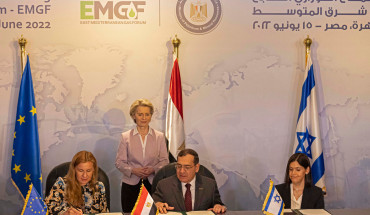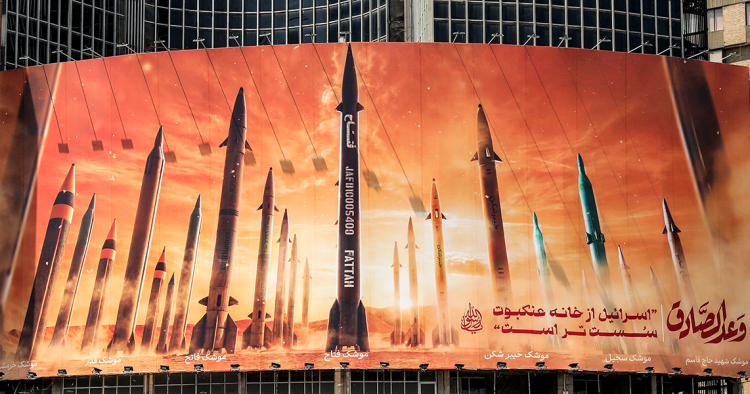A version of this article first appeared as part of an Expert Views special feature on the new rules of the game in the Iranian-Israeli conflict.
The recent blow-for-blow strikes by Iran and Israel are bound to result in some introspection in Tehran, although this will not be immediately evident. For now, Iranian officials are seeking to show that the fusillade of drones and missiles the Islamic Republic fired at Israel on April 13 has reestablished mutual deterrence. This latest round of escalation was sparked by Israel’s airstrike on the Iranian embassy in Damascus on April 1, which killed several key commanders of the Islamic Revolutionary Guard Corps, and following Iran’s retaliatory strike on April 13, Israel opted to respond in a limited fashion on April 18.
Now that the gloves are off, Iran and Israel cannot go back to the era of “shadow war.” Each side has demonstrated that it can target the other’s sensitive sites with its military arsenal. Still, on the Iranian side, it is the first time since the launch of the “Axis of Resistance” some 20 years ago that Tehran has to choose whether it wants to center its entire national security strategy around the conflict with Israel.
Iran’s proxy model
Going forward, Tehran could choose to handle this conflict through political and diplomatic means rather than via the Axis of Resistance, a model of proxy warfare that has isolated Iran from the West and made its Arab neighbors deeply uneasy about its ultimate regional goals. After all, for Tehran, the fundamentals of the cost-benefit equation justifying the proxy warfare model have shifted considerably in recent weeks.
The proxy model was always meant to enable Iran to fight its regional rivals away from the Iranian homeland and at a relatively low financial cost. With the Iranian-Israeli rivalry having entered the stage of direct conflict, this is no longer possible.
Iran is not the first country to use proxies to advance its agenda. Over the last century, the US, the USSR/Russia, and China have all used proxies far more extensively in their pursuit of power. And yet each of these states would abandon a proxy if the costs exceeded the benefits. Moreover, the costs of engaging in a proxy war are never measured solely in commitment to an ideological cause but also in factors like overall geopolitical interests, financial expense, and general domestic support for a proxy strategy.
In the case of Iran today, its regional proxy model is as much a product of opportunities that arose in the last 20 years — when political unrest broke out and security vacuums emerged in places like Syria or Yemen — as it is a consummate alliance. The best example of this is Tehran’s fickle ties with the regime of Bashar al-Assad in Syria.
In fact, Assad’s latest maneuverings are the sort of realpolitik Tehran should learn from. The Syrian president is not only reportedly holding meetings with the Americans — which Tehran itself refuses to do — but he has also declined to join Tehran in its ideological fixation on Israel.
Media reports in Tehran suggest that elements within the Assad regime might even be passing intelligence on to the Israelis so they can target Iranian assets in Syria. Now that the Assad regime has survived the popular revolution, the Iranians are perhaps no longer needed. The validity of such reports aside, the point is that Assad’s loyalty is not a foregone conclusion for Tehran.
Meanwhile, Israeli media reports suggest that not only Jerusalem but also Russia and the United Arab Emirates are pressing Assad to refrain from joining the Iranian-Israeli conflict and to keep the Syrian border areas with Israel out of any armed hostilities. The same media reports also point to the relative calm in areas bordering the Golan Heights as evidence.
What is also certain is that the Assad regime has spent the last few years cultivating ties with the wealthy Gulf states, such as the UAE, that might be interested in investing in Syria’s reconstruction if the commercial and political conditions are right. In this context, sanctions-hit and cash-poor Iran is simply unable to offer Syria much, which is a real source of anxiety in Tehran, prompting concerns that Iran might lose out in post-war Syria.
All of this is to say that Iran has plenty of reasons to take a cold, hard look at the costs and benefits of its present regional agenda and, most importantly, its proxy war strategy against Israel and its American backers. The potential fallout has never been this great and the whole enterprise looks increasingly shaky, with some of Iran’s partners in the Axis of Resistance at best conditional allies pursuing their own agendas, while Iranian public opinion is squarely opposed to the regime’s perilous proxy war strategy.
An opening for a new diplomatic push?
As of today, there is no indication that the Iranian leadership is seriously reconsidering Tehran’s regional agenda, even though reports suggest that Iran is scaling back its physical footprint in some areas to reduce the number of potential targets for Israel and the US. But the latest Iran-Israel tensions might have, at least in the short term, created an opportunity for a renewed US-Iran diplomatic push centered on reviving talks about the fate of Iran’s nuclear program.
This latest drive rests on the fact that Washington and Tehran managed to communicate and contain the recent Iran-Israeli clashes. The American side was not only able to shape Israeli actions but also Tehran’s, and as a result a broader conflict was avoided. It appears that this US-Iran management of the crisis might have given cause for Tehran and Washington to look for ways to kick-start the dormant nuclear talks. Iran’s Deputy Foreign Minister Ali Bagheri is said to be talking to the Americans via third-party mediators — most likely Qatar and Oman — while Iran’s UN Ambassador Saeed Iravani is doing his part in New York to push for new nuclear negotiations.
Iranian media have gone so far as to suggest that new official US-Iran nuclear talks could begin by the end of May. If so, this is due to a sense of urgency on both sides. Tehran can claim that its recent barrage of missiles and drones against Israel means it will re-enter the talks with a strong hand and in the big hope that it can reduce the burden of sanctions on the deeply suffering Iranian economy. For its part, Washington has one main motive: to dissuade Tehran from considering weaponizing its nuclear program. Addressing this issue has taken on a new urgency of late, particularly if the Iranians’ main takeaway from the recent tit-for-tat exchange with the Israelis is that Tehran has to resort to nuclear deterrence going forward.
Meanwhile, in the context of possible new nuclear talks, time is of the essence. The official expiration of the 2015 Iran nuclear deal, known as the Joint Comprehensive Plan of Action (JCPOA), is October 2025. At that point the UN Security Council is due to terminate Resolution 2231, which endorsed the JCPOA back in July 2015, and close the Iranian nuclear file. Despite the need for haste, if there are to be new nuclear talks between Tehran and Washington, and this still only a remote possibility in an US election year, one would hope that the two sides will quickly seek to expand them to include ways to reduce broader regional tensions as well.
After all, the main reason that the 2015 nuclear deal was never allowed to run its course was the pressure placed on it by regional tensions between Iran and its rivals. The same mistake should not happen with any new nuclear compromise. If nothing else, regional tensions, particularly between the Iranians and the Israelis, are considerably higher today than they were back in 2015, and the war in Gaza will keep the region on a boil as long as it continues. On the positive side, all the major powers involved, including Iran, Israel, and the United States, have demonstrated a deep reluctance to escalate to a broader conflict. If there is a silver lining in the latest Iran-Israel cycle of retaliation, it is that it has provided an opportunity for introspection at a critical time.
Alex Vatanka is the director of the Iran Program at the Middle East Institute and a Senior Fellow with MEI’s Black Sea Program.
Photo by ATTA KENARE/AFP via Getty Images
The Middle East Institute (MEI) is an independent, non-partisan, non-for-profit, educational organization. It does not engage in advocacy and its scholars’ opinions are their own. MEI welcomes financial donations, but retains sole editorial control over its work and its publications reflect only the authors’ views. For a listing of MEI donors, please click here.













